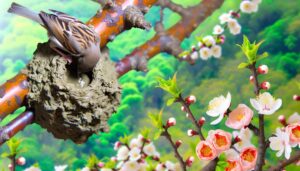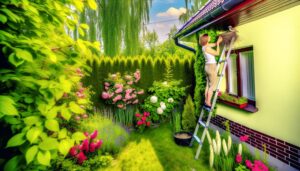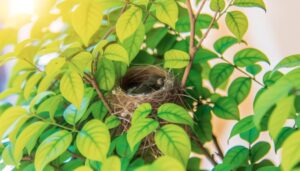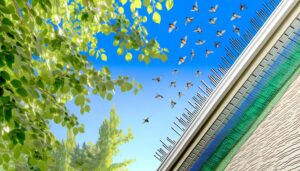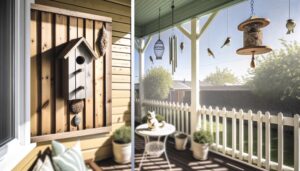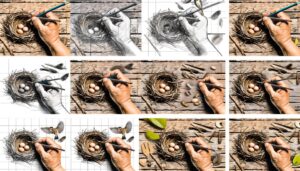Let My Sparrow Make the Perfect Nest in 5 Steps
To help your sparrow build a nest, consider their natural behaviors. Select a secure location elevated and hidden to minimize predator risks.
Provide clean, chemical-free materials like twigs, grass, and feathers. A birdhouse positioned 6-10 feet above ground with a 1.25-inch entrance hole is ideal.
Ensure it has proper ventilation and drainage. Install predator guards like baffles and metal barriers.
Cultivate a biodiversity-friendly garden to supply natural food sources. Observing their skillful construction and feeding routines can offer captivating insights into avian life, enhancing your experience.
For a deeper understanding, gather detailed techniques and tips.
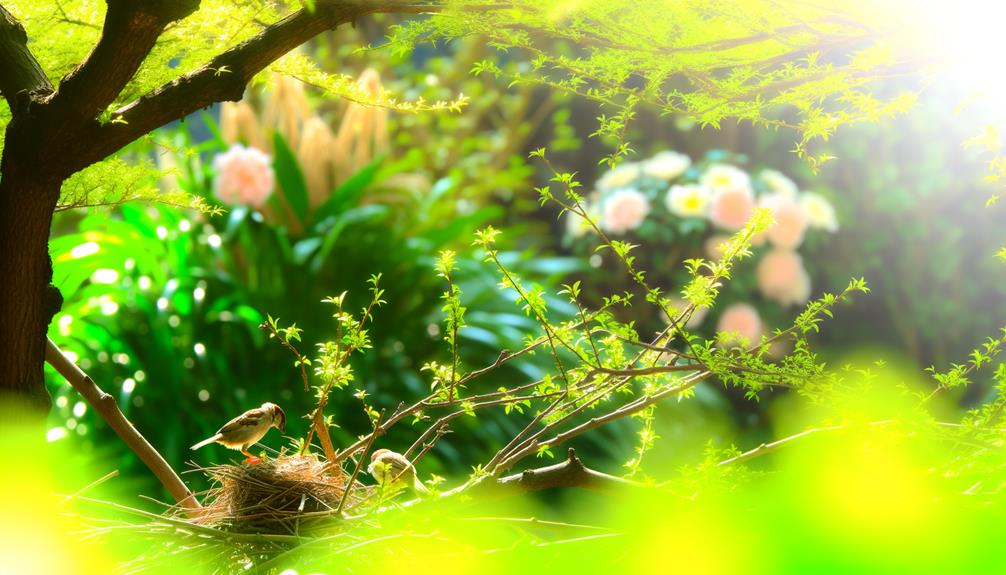
Key Takeaways
- Provide a safe, elevated, and concealed location to minimize predator risks.
- Supply a variety of clean, chemical-free nesting materials like grasses, twigs, and feathers.
- Set up a birdhouse with a 1.25-inch entrance hole positioned 6-10 feet above the ground.
- Ensure the birdhouse has ventilation, drainage, and faces away from prevailing winds.
- Implement predator deterrents like baffles and metal barriers to protect the nesting site.
Understanding Sparrow Behavior
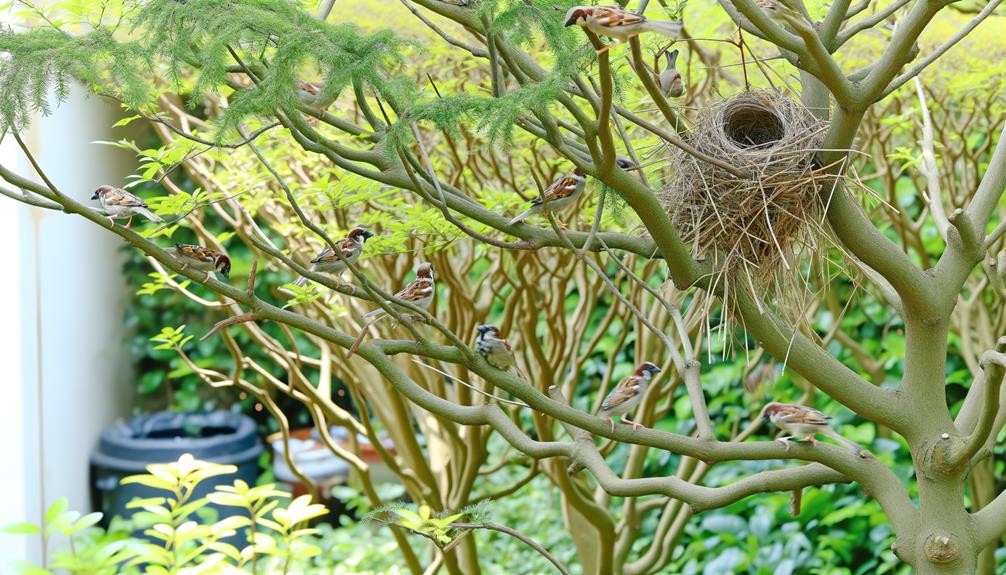
Sparrows often exhibit complex social structures and behaviors that are crucial for their survival and reproduction. You'll notice that sparrows engage in communal roosting, a behavior where they gather in large numbers to sleep, which helps conserve heat and deter predators.
They also have a hierarchical system, where dominant individuals have priority access to resources like food and nesting sites. Understanding these social dynamics is necessary if you want to support their nesting efforts.
Observing their courtship displays, such as males singing and performing flight maneuvers, can provide insights into their mating rituals. By recognizing these behaviors, you can create a conducive environment that encourages sparrows to build nests, ensuring their safety and fostering their reproductive success.
Choosing the Right Location
When selecting a nesting site for sparrows, prioritize areas that are safe from predators such as cats and larger birds.
Make sure the location provides access to suitable nesting materials like twigs, grass, and feathers.
Your chosen spot should balance safety and resource availability to support successful breeding and rearing of chicks.
Safe From Predators
Why is it important to select a nesting site that offers protection from predators for your sparrow?
Predators such as cats, snakes, and larger birds pose significant threats to sparrow nests. A well-chosen location minimizes these risks, ensuring both eggs and fledglings remain safe.
Opt for sites that are elevated and concealed, like dense bushes or eaves. Your keen observation will reveal areas where predators can't easily reach or see.
Monitor the chosen site frequently to detect any signs of predator presence. Additionally, avoid placing nests near feeding stations that attract other birds, as competition can lead to increased predation.
Suitable Nesting Materials
Selecting the right nesting materials is essential, as they directly impact the structural integrity and insulation of the sparrow's nest. Opt for natural fibers like grasses, straw, and small twigs. These materials provide flexibility and strength.
Additionally, incorporating softer items like feathers, moss, and cotton can enhance insulation, ensuring eggs and chicks remain warm. Avoid synthetic materials; they can retain moisture and lead to mold growth. Observe the sparrow's natural behavior to identify preferred materials.
Your goal is to create an environment that mimics their natural habitat. Place these materials near the nesting site, ensuring easy access. By carefully selecting and providing these materials, you'll contribute to the sparrow's comfort and nesting success, fostering a thriving avian community.
Providing Nesting Materials
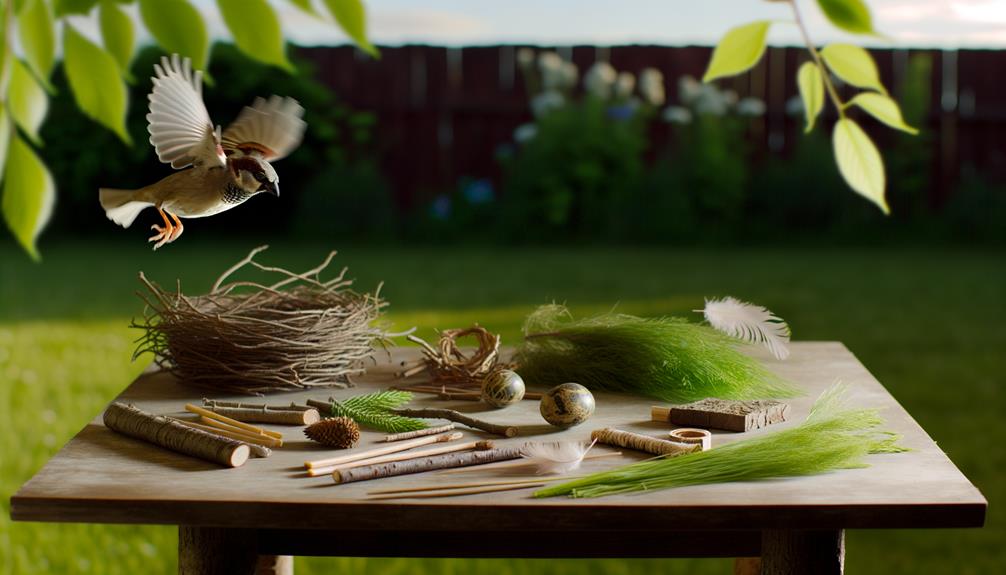
Supplying sparrows with suitable nesting materials is crucial for guaranteeing their successful breeding and comfort. You should provide a variety of materials such as grasses, twigs, and feathers, which sparrows prefer for constructing their nests.
Place these materials in accessible locations around your yard or garden. Observing sparrows, you'll notice they select fine, flexible materials for the nest's interior and sturdier items for the exterior.
Guarantee materials are clean and free of chemicals to prevent harm. Additionally, small pieces of yarn or cotton can offer additional insulation.
Setting Up a Birdhouse
To further support sparrows in your yard, setting up a birdhouse provides them with a secure and sheltered space for nesting.
Choose a birdhouse with a 1.25-inch entrance hole to accommodate sparrows while excluding larger species.
Position the birdhouse 6-10 feet above the ground to mimic their natural nesting height. Assure the birdhouse faces away from prevailing winds to reduce exposure to harsh weather conditions.
Incorporate ventilation holes to regulate temperature and drainage holes to prevent water accumulation. Use untreated wood to avoid harmful chemicals.
Regularly inspect and clean the birdhouse to maintain a hygienic environment.
Ensuring Safety From Predators
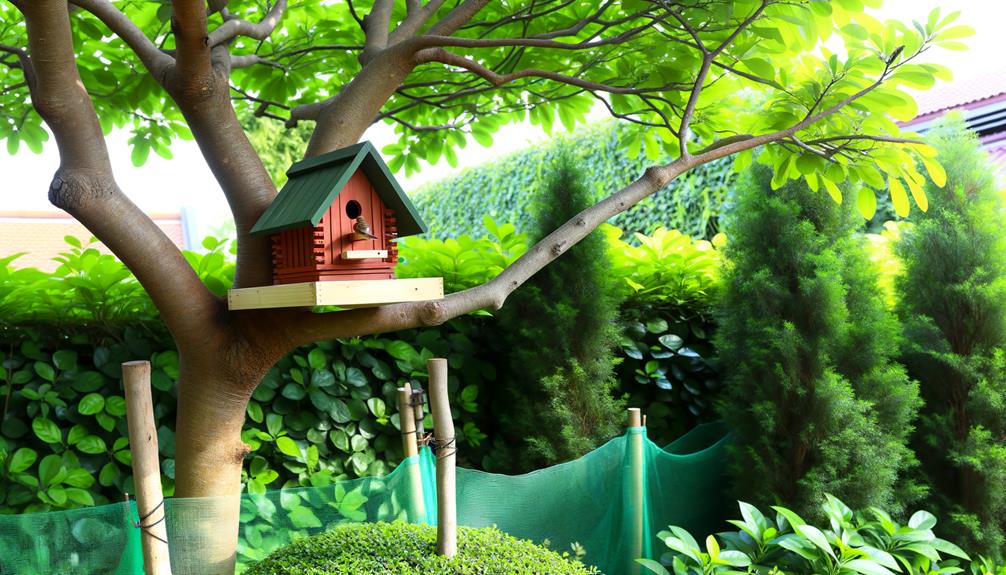
A critical aspect of supporting sparrows involves implementing measures to effectively deter predators from accessing their nests. To ensure safety, you should place the birdhouse at least 10 feet above the ground, away from easy climbing paths. Install predator guards, such as baffles or metal barriers, to prevent snakes and raccoons from reaching the nest. Additionally, situate the birdhouse in an open area to make it harder for cats to ambush.
| Predator Type | Deterrent Method | Effectiveness |
|---|---|---|
| Snakes | Install baffles | Highly effective |
| Raccoons | Metal barriers | Moderately effective |
| Cats | Open placement | Effective |
Maintaining a Clean Environment
In addition to predator deterrence, maintaining a clean environment around the birdhouse is essential for the health and well-being of sparrows. You'll need to regularly inspect the vicinity for accumulation of waste, dead insects, or decaying plant matter, as these can harbor pathogens.
Use a gentle biodegradable cleaner to sanitize the birdhouse interior, ensuring no harmful residues remain. Remove old nesting materials between breeding seasons to prevent parasite infestations. Monitor for mold and mildew, which can compromise respiratory health.
Monitoring the Nesting Process
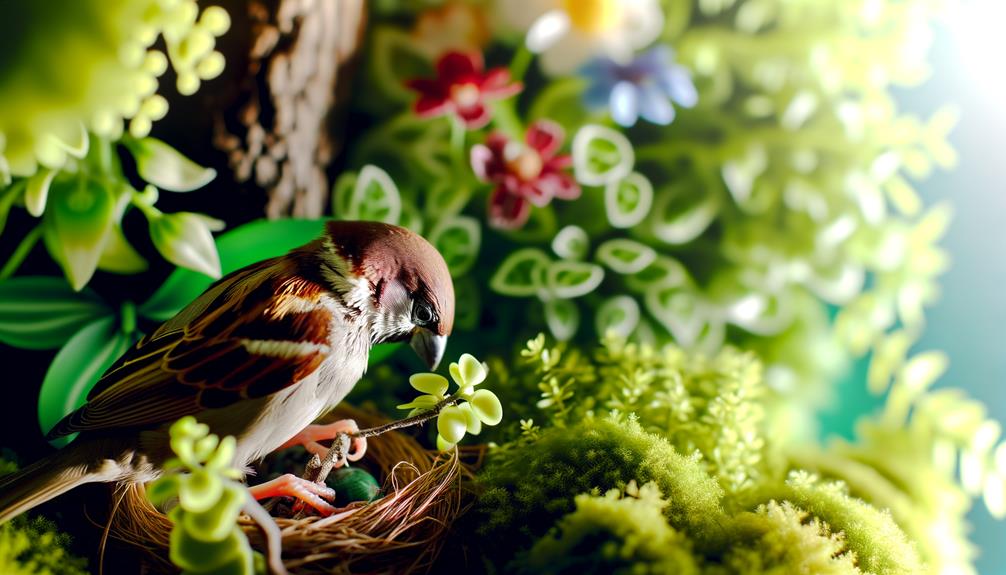
To effectively monitor the nesting process, you should carefully observe the sparrow's behavior, noting any changes or patterns.
Record the nesting progress daily, including the construction stages and materials used.
Make sure you implement safety measures to protect both the bird and nest from potential threats.
Observe Sparrow's Behavior
You should meticulously document the sparrow's activities, noting specific behaviors such as nest-building material selection and frequency of visits to the nesting site.
Observe the sparrow's preferences in materials—twigs, grass, feathers—and identify any patterns.
Track the intervals between visits to understand the bird's nesting rhythm. Pay attention to the sparrow's interactions with its environment and potential threats.
Note any changes in behavior that may indicate stress or satisfaction with the nesting site.
This detailed observation will help you provide a supportive environment, ensuring the sparrow's needs are met.
Your ability to serve the sparrow's requirements enhances its nesting success, fostering a harmonious coexistence.
Record Nesting Progress
Begin by creating a detailed log to systematically record every stage of the sparrow's nesting progress, noting materials added, structural changes, and any signs of egg-laying or incubation.
Document the types and quantities of materials the sparrow uses, such as twigs, grasses, and feathers. Observe and note the nest's evolving architecture, including the formation of the nest cup and any modifications made.
Pay close attention to the behavior indicating egg-laying, such as increased time spent in the nest or visible egg presence.
- Witness the first signs of life as eggs appear.
- Marvel at the intricate construction process.
- Experience the excitement of potential hatchlings.
Your detailed observations will contribute to a richer understanding of the sparrow's nesting behavior and support its successful reproduction.
Ensure Safety Measures
While observing the nesting process, apply safety measures to protect both the sparrow and its nest from potential threats such as predators, harsh weather, and human disturbances.
Install predator guards around the nesting area to deter cats, snakes, and larger birds. Make sure that the nest is in a sheltered location to minimize exposure to rain and strong winds.
Limit human interaction by maintaining a safe distance and avoiding loud noises. Regularly monitor the nest for any signs of distress or damage, and be ready to intervene if necessary.
Encouraging Natural Food Sources
Integrating a variety of native plants in your garden can greatly boost the availability of natural food sources for sparrows. Planting species that produce seeds, grains, and insects will secure a sustainable food supply.
Observations show sparrows are particularly attracted to dense shrubs and wildflowers. To evoke a sense of purpose, consider the following:
- Nurture biodiversity: Cultivate a mix of plants that support different insect populations.
- Promote ecological balance: Native plants maintain the natural ecosystem, offering food and shelter.
- Foster community well-being: A thriving garden benefits not just sparrows but all local wildlife.
Observing and Enjoying the Nest
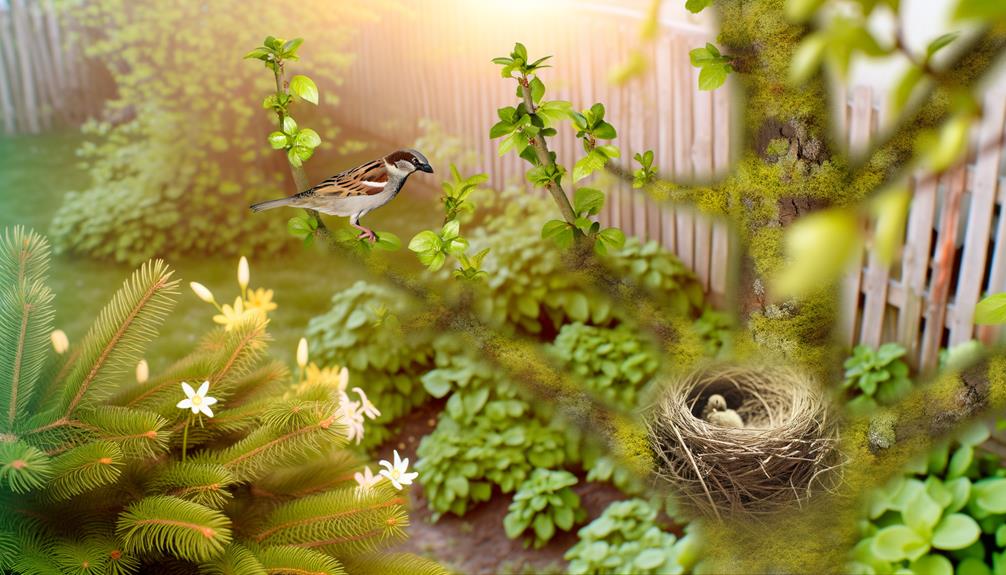
Observing a sparrow's nest offers a fascinating glimpse into avian behavior and the intricate process of raising young. Position yourself at a respectful distance to avoid causing stress.
Note the nest's construction – woven with grass, twigs, and feathers, demonstrating remarkable dexterity.
Watch for incubation behaviors; the female typically incubates the eggs, maintaining ideal temperature and humidity.
Once hatched, observe the feeding routine: both parents tirelessly bring insects and seeds to nourish the chicks.
Listen to the vocalizations – chirps vary in pitch and frequency, signaling different needs.
Document these behaviors to share your findings, aiding others in understanding and fostering avian life. By doing so, you contribute to a broader appreciation and conservation effort for these remarkable birds.
Conclusion
You've now equipped yourself to help your sparrow confidently build its nest. Like a meticulous architect, you've selected the ideal location, supplied nesting materials, and guaranteed safety from predators. By maintaining a clean environment and providing natural food sources, you're fostering a supportive habitat.
Continue monitoring the nesting process, making detailed observations. Ultimately, this journey allows you to observe and enjoy the fascinating behaviors of sparrows up close, enriching your understanding of these remarkable birds.

